Few people are fully aware to what extent the railways, and certain sections of the army, were able to play such a large part in assisting the war effort during the two world wars. Brian Bell, who served at Longmoor in the 1950s, outlines how both the Allies and the Germans realised just how strategic the railways were as something to attack and something to defend.
It was during the First World War that the railways gave the ability to transport masses of munitions and men to the front in France, whereas in the Second World War the railways were vital, not only in transportation, but also in enabling the rapid reconstruction of destroyed French and German railway systems to become operational again.
Following the D-Day landings and the Allies’ attack, it was essential to have the railways operational, even if only under emergency conditions, but then, as the Germans retreated, their number one priority was to destroy as many bridges and rail track possible to halt the Allies’ advance. This became the priority of the Royal Engineers. However, we are pressing on too far and we must start right at the beginning to understand how it all began.
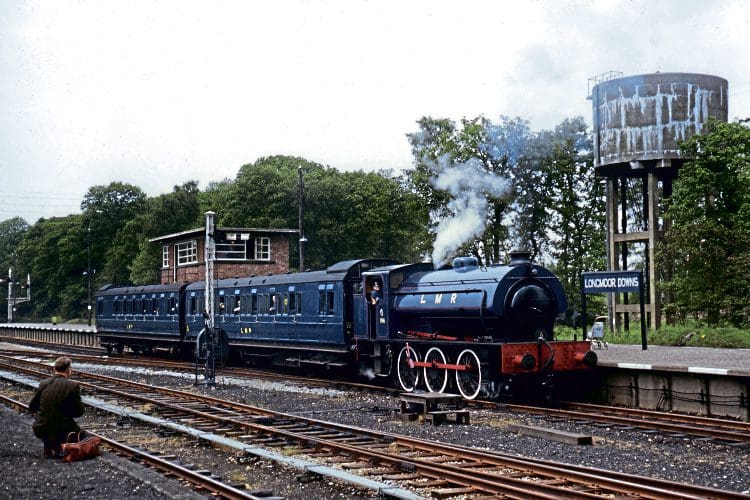
During the First World War, as the fighting became far more intense, a great many French railway enginemen volunteered for military service, plus French motive power became vastly overworked and unable to cope with wartime demands.
Enjoy more Heritage Railway reading in the four-weekly magazine.
Click here to subscribe & save.
Realising this, the British military decided that many more locomotives were required for these vital roles and decided to ask several British railway companies what type of locomotives were available to transfer to France to assist in the war effort.
Fortunately, Robinson of the Great Central, had just three years earlier in 1911, designed the 11F 2-8-0 (later class O4) for freight service on the GCR, mainly for heavy coal traffic duties in the East Midlands. As the war dragged on into 1917, the military recognised that this type of engine could be ideal for what they were seeking and requested Robinson to construct a further 93 for military service. Although only the basic model, these locomotives became operational by a new unit formed from the Royal Engineers, and known as the Railway Operating Division. The engines subsequently became known as RODs for their remaining operational life.
Excellent steamers
Following the end of the war, these engines were recognised as a superb design, being powerful and excellent steamers, and Robinson built a further 24.
Eventually, practically all of the ROD 2-8-0s were transferred to the LNER before finally being taken over by British Railways when the Big Four were nationalised. No. 63601, the original built in 1911, has been preserved and is still in operation today.
The military, recognising what a considerable and essential contribution the railways had played during the First World War, realised that this branch of the Royal Engineers should remain operational in event of any further conflicts taking place. This meant the urgent need to have its own military railway so it was possible to train new recruits to be able to operate railways during wartime conditions.
By good fortune it was discovered that an ideal site had been authorised for construction in Hampshire in 1902, when an 18in gauge tramway was laid to assist in removing 68 large corrugated iron huts from Longmoor military camp to nearby Bordon. Later, in 1905-1907, this railway was relaid to standard gauge and initially known as the Woolmer Instructional Military Railway.
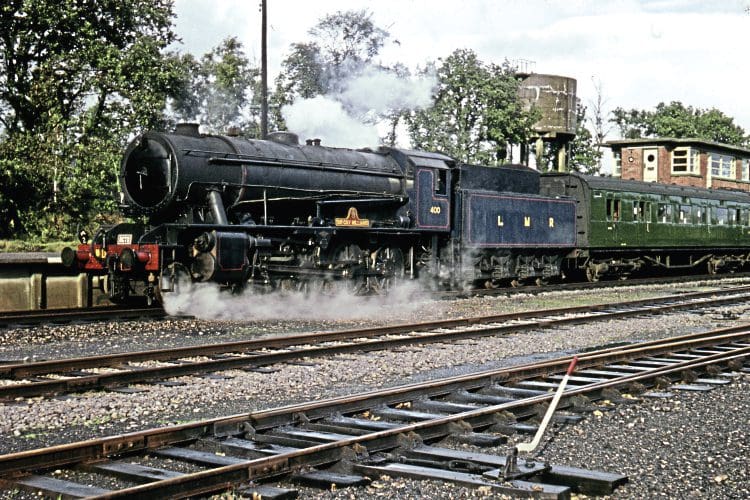
In 1933 a further extension was constructed, this time in the opposite direction towards a small town called Liss, where the line was connected to the electrified Waterloo-Portsmouth main line. The whole site was renamed the Longmoor Military Railway in 1935. The line stretched for eight miles in total. The stations and junctions included:
■ Bordon – the northern terminus, with platforms adjacent to the Southern Railway Bordon station. Here a single track railway with a passenger train service connected to the Southern main line at Bentley. The surrounding areas around Bordon and Longmoor included vast uninhabited open and forest land, ideal for military training and especially by the Royal Armoured Corps for tank training.
■ Oakhanger Halt – serving the village of Oakhanger, Hampshire. To gain access to Bordon station from Oakhanger, required a vast downhill loop in the LMR track. This was due to gaining rail access to the numerous numbers of engineering stores depots (ESDs) where vital military engineering stores were stored.
■ Whitehill Triangle Junction with a branch to the Hollywater Loop and Hopkins Bridge site where the Royal Engineers were building a new type of suspension bridge.
■ Two Range Halt. Alongside this particular station were two open fields where two massive rifle ranges had been constructed for military training.
■ Longmoor Downs – the original terminus, and largest station on the line, serving the military camp and now practically in the centre of the whole line. It was quite a modern station with one central island platform serving tracks either side. A large modern brick signalbox was also situated in the centre of the platform, controlling numerous tracks with junctions to the Hollywater loop line, various sidings and also to the nearby large engine shed.
■ Weavers Down Halt – A station was constructed to serve another massive barracks complex on the eastern side of Longmoor Military Camp. This was for the AER (Army Emergency Reserves) who were men recalled from their National Service duties for additional two weeks training every year.
■ Liss – the southern terminus, with a platform adjacent to those serving the SR Waterloo-Portsmouth main line. There was a rail connection here for the transfer of various items of rail transport equipment.
An additional three-mile loop line ran eastwards from Longmoor Downs station towards a site known as Hopkins Bridge and then onto Whitehill Junction where it connected up with the so-called ‘main line’. This was completed in 1942 and provided circular running to the main line, allowing for improved training without the need to turn trains at the terminals either end.
Another essential requirement of this railway was to serve the numerous engineers’ stores depots constructed within its confines and during the Second World War it was a scene of frantic activity in the build-up to the Normandy landings on D-Day. Places and sidings that are shown on the map such as Martinique, Oakhanger, Toronto, Vancouver etc are such depots.
It was during the Second World War and as the need for more extra motive power became vital in Egypt and North Africa, then later following the D-Day landings, Riddles of the LMS was asked, in 1943, to design and construct a further number of heavy 2-8-0 and 2-10-0s, later known as ‘Austerities’ or WDs (commonly called ‘Dub-Dee’). For shunting purposes Riddles also designed a number of smaller 0-6-0STs (later LNER J94).
Following the end of the war a large number of these were transferred to the LNER; 733 WD2-8-0s in all, plus 25 2-10-0s, and 75 0-6-0STs. The Austerity 2-10-0 was designed to operate on the Suez Canal, where the British military operated the whole system.
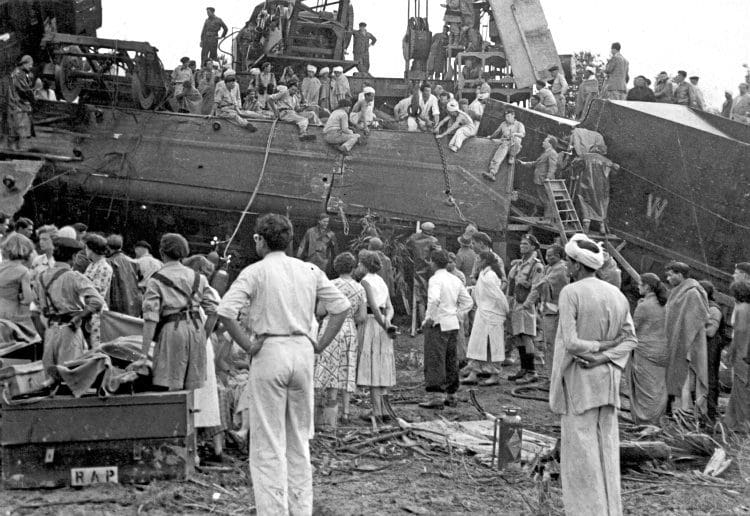
Just four units
Following the end of the Second World War there were just four units based at Longmoor. These comprised:
No. 49 Railway Regiment, a large unit permanently based there that normally operated and controlled the whole of the Longmoor Military Railway.
No. 83 Railway Training Squadron, a unit in which soldiers who had just completed
their initial six weeks’ military training were sent to train on operating the railways on a three-month course, before being posted to other parts of the country, or similar places around the world, the Suez Canal in particular, where the military operated the railway system on the canal banks.
Nos. 8 and 10 Railway Squadrons. Both units consisted of around 200 men, all trained as footplatemen, signalmen, platelayers, fitters and mechanics, including one engineer who could drive all types of heavy machinery, cranes, diggers bulldozers etc. These units were all ready at a moment’s notice, in the event of an emergency, to take over various railway operations, wherever was required. During the war there were several other similar units operating in France, mainly due to the fact that as the Germans began to retreat, they would destroy as much of the railways as possible, knowing full well how valuable they were. However, following the end of the Second World War Nos. 8 and 10 squadrons were the only two left operational at Longmoor and they alternated every few years to operating the railways on the Suez Canal, which was then under British military rule.
No. 10 Squadron was operating there when it was thrown out by President Nasser in 1955, returning hurriedly to Longmoor still wearing tropical uniforms.
Fortunately, that same year MGM decided to make a film of the attempted assassination of Ghandi of India, starring Stewart Granger and Ava Gardner, by blowing a train up, supposedly with Ghandi on. All the railway action was filmed at Longmoor. No. 10 Squadron, because they still had their tropical gear, were filmed as military actors rescuing people at the crash scene. It was highly lucrative too, or so I was informed. I only guarded the commandant’s personal carriage, being used as Ava Gardner’s dressing room!
No. 8 Squadron, my unit from 1954 to 1956, was based at Longmoor in the early 1950s and was engaged in constructing a new type of bridge on the Hollywater loop line for either rail or road use, to replace the versatile, portable Bailey bridge, which was such a valuable and essential necessity during the Second World War. This new bridge, purported to have been designed by the military engineer behind the famed and invaluable Mulberry Harbour constructed for the army during the Normandy D-Day landings, was, to coin a phrase, like a gigantic large-scale Meccano set, something to transport easily and more importantly, quick to construct.
Another important feature was the fact that unlike the Bailey bridge which, because of its short length, required numerous upright pillar supports, this new bridge had a much greater span. As my two-year National Service was coming to an end, the bridge was nearing completion and strength trials were underway. I was chosen as a crew to visit Liss station to take over a large SR 4-8-0T, required apparently because of its exceptional wheelbase weight for bridge testing. I was accompanied by my driver, plus a Staff Sergeant Instructor, a guard and a fitter. The BR crew looked on in amazement as five of us stepped aboard. The army didn’t do things by half. I was pleased I wasn’t chosen to fire the engine during the tests, especially when they also decided to use two Austerity 2-8-0s at speed. That was frightening! Whether the bridge was a success I can’t say as I had left.
For training purposes the whole unit was transferred to take over and operate one of two Command Ammunition Depots (CADs) based either at Bramley in Berkshire or Kineton in Warwickshire for three months annually.
Both sites occupied very large square mile tracts of military land, where numerous large underground bunkers had been constructed to store all kinds of military munitions. Each bunker was interlinked by railway tracks, leading to a marshalling yard connected to the BR system. All the motive power was provided by Austerity 0-6-0STs fitted with spark arresters. Normally they were operated by civilian staff under military control.
As previously stated the number one priority at Longmoor was the training of military personnel to be able to operate railways during wartime and for around a 10-year period following the end of the Second World War literally thousands of men, primarily National Service conscripts, were trained there for that purpose. Besides being a very large tract of land around eight miles square, the camp itself was similar to a small modern town with the B2131 road from Liphook passing through it, directly alongside the modern LMR Longmoor Downs station.
Parade ground
Also nearby were the camp commandant’s (a brigadier) imposing headquarters (whatever you did you didn’t make black smoke in that vicinity!) together, naturally, with its massive parade ground. Men were still required to parade regularly every morning before resuming trade training, plus perform guard duties and ceremonial parades. Other offices included a large superbly equipped Signal Training School and nearby several tracks led to a large engine shed and its relative facilities.
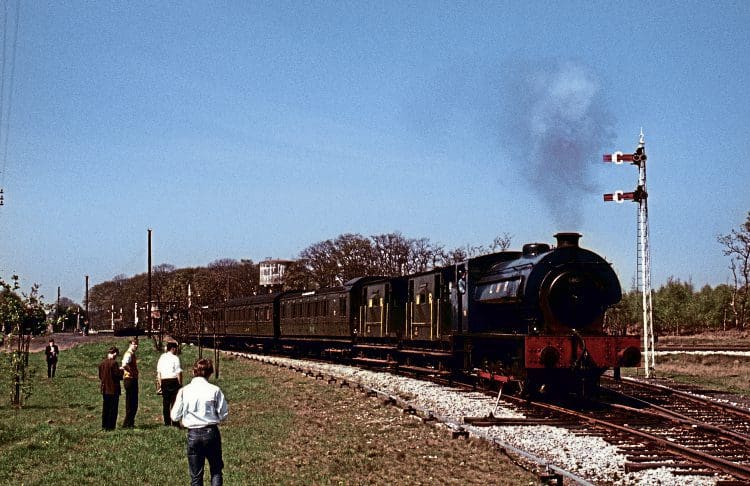
In the mid-1950s around 20 steam locomotives of various types were stationed there, all painted an immaculate bright blue with red wheels lined with white rims. These included four 2-10-0s, all oil burning, (I could never make them steam without making black smoke!), including No. 600 Gordon, now preserved. The other three 2-10-0s were previously operated by the Americans, (all naturally with enormously long names after various high-ranking generals). There were several smaller Austerity 2-8-0s, an American 0-6-0 side tank, and numerous Austerity 0-6-0STs that were all equipped with vacuum brakes to regularly haul the daily passenger train services.
Drivers were normally three-year regular soldiers with very limited knowledge of driving and several treated it like driving a fast car. The regular daily passenger services were operated by the 0-6-0STs that rolled dangerously when travelling at speed because of their top-heavy design. I regret to say that some of these particular drivers treated it as a joke.
Every evening at 6pm a unit of around 20 men was selected for fire protection duties and in event of any fire or emergency they were the first personnel to be called. However, their other duties included one group of four men assigned to guard the armoury (armed with rifles without bullets!) four to the cookhouse kitchen for peeling potatoes, one man to sit in the cinema with a fire extinguisher (the favourite) and the remainder were assigned to the engine shed to clean locomotives. Commit some slight misdemeanour and you could be assigned these duties for at least a week or possibly more.
Military personnel
To accommodate such a very large number of military personnel, the camp site included numerous rows of modern two-storey brick army billets, two large mess canteens, plus workshop buildings of every description. For recreation it had two large NAAFI and Church of England cafe/restaurants with indoor sporting facilities, a cinema, and a fine garrison church. Around the perimeter of the camp were numerous married quarters, a school and some fine spacious sports grounds. Due to its location it had no security fencing or entrance gatehouses.
As a training railway it was often being constructed or deconstructed. The layout would change often, and at one time there was a machine that could lay 1500 yards of track a day. At its peak, the railway ran to over 70 miles of operational track and sidings.
The vehicles and stock on the LMR were very much an assortment to give the maximum training opportunities. Well over a thousand locomotives had associations with the railway during its time, although many only through the need for storage. The same was true of the signalling systems at various locations on the line, including an Army version of flag signalling, (designed to be used in an emergency when all signalling had been destroyed). The section between Whitehill and Hogsmoor was operated by this system; the signalman using flags during the day and hand-held paraffin lamps during hours of darkness. Some of the main line was twin operated under a normal block operation signalling, using semaphore-type signals, whereas single line operation was under the single line block system.
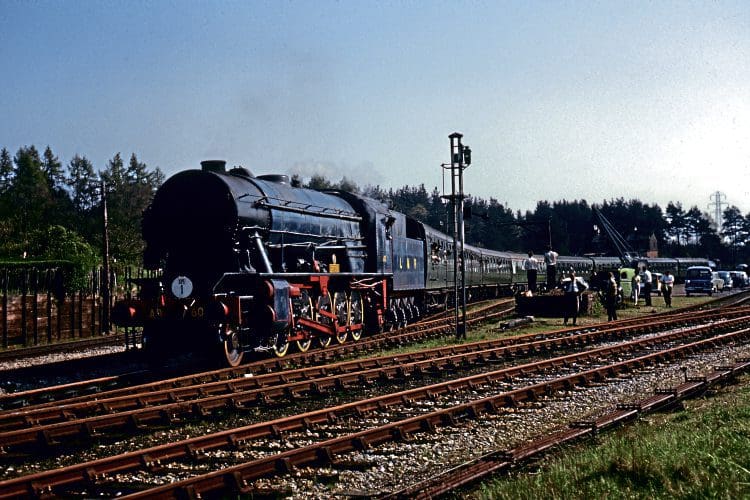
The railway had a large number of standard passenger carriages as a passenger service was operated over the line throughout the day running to a proper timetable between Liss and Bordon. This was nominally for personnel employed at the variety of engineers’ stores depots based around the railway and for a large number of civilian staff employed at various establishments. The railway also operated a large number of freight wagons of various types, including a large steam crane for permanent way work. After the end of the Second World War the collection also included captured enemy equipment, including a ‘Schienenwolf’ or railroad plough, a German wagon that dragged a huge hook behind it to destroy sleepers and render railway lines unusable to advancing enemy troops.
Reduced in later years
With a declining military role for railways, both in Britain and the rest of the world, it was inevitable that the significance of the facilities offered by the LMR would be reduced in later years. Even so, the LMR was still important enough for the tracks of the Bentley to Bordon branch to be left in place until the passenger services were withdrawn on September 16, 1957. This line remained in place as, although there was a BR connection at Liss, the Bordon branch made it easier to accommodate the movements of military traffic at short notice. In 1966 the movement of goods over the Bordon branch was suspended, and the line was taken up in 1967. I have never been back over the past 60 years, but I understand that very little remains.
Finally, steam enthusiasts will no doubt be interested to know how these locomotives, designed for military use, performed on BR when they were eventually transferred for normal operational use. Fortunately, during my footplate career I worked on all three different types. The Robinson ROD (O4) 2-8-0 remained in operation until almost the end of steam and was an excellent freight locomotive, capable of handling the heaviest coal trains, which is what they were designed for – excellent steamers and good riding. Unfortunately, Edward Thompson, who also did not appear to appreciate Gresley’s designs, as he altered several of his locomotives, also decided to modify several Robinson O4s by changing the boiler from a Belpaire-type to the 100A B1 type with a long narrow firebox. These were still capable engines but as any old time steam man would agree, not in the same class as the original.
The Austerity 2-8-0s were powerful engines, also well capable of hauling the heaviest loads, and on the Eastern Region the mainstay of all bulk hauling, but unfortunately, due to poor maintenance, they suffered from blocked boiler tubes that obviously caused steaming problems, especially if, as usual, they were fired with poor quality coal.
A major fault was when running downhill without steam on the engine and tender rebounded off one another causing quite a bumpy ride. They were always dirty and scruffy and very rarely, if ever, cleaned unless a set of engine cleaners misbehaved and then the chargehand foreman would find them the scruffiest ‘Austerity’ to smarten up!
Easy to fire
Lastly the 0-6-0STs. These were a vast improvement on the multitude of ancient shunting engines and pilots in regular use during that period – good steamers, easy to fire and a pleasure to drive, especially for shunting purposes when you were constantly reversing to and fro.
So, all in all, despite being cheaply designed they were one of the mainstays of freight operations on the ER and, thankfully, several are preserved today.
Read more News and Features in Issue 236 of HR – on sale now!
Archive enquiries to: Jane Skayman on 01507 529423 – [email protected]
Advert
 Enjoy more Heritage Railway reading in the four-weekly magazine. Click here to subscribe.
Enjoy more Heritage Railway reading in the four-weekly magazine. Click here to subscribe.




